Networked improvement communities Douglas C. Engelbart. 1.* - unedited transcript - Welcome to Session six of "The Unfinished Revolution." As you will see, this session is gradually scaling up, as sort of a scale of sizes of considering things within the strategic framework that we are talking about. But before we get into this, we have a short announcement by Peter Yim. Peter Yim, about availability of slides Thank you, Peter. One of the
interesting thing that is happening to me personally, over the course of
this is I keep groping about who is it. I am really addressing I know that
there is a spectrum m of interests and knowledge background. I keep being
oriented so heavily about the scale of strategy so I am going to start
right out hitting that again, and if it somehow seems to people, "oh he
said that before", its that year after year for the last 40 years the trouble
that I run into besides not being organized and incoherent things like
that, is that is it very hard to get people to think about the kinds of
changes that really are there to go after and that are really going to
happened for us. So this is just over and over again. When at times like
what we are facing now that is really coming bout us is that change is
just monumental. It is going to come we really have to get used to cracking
out heads open about what is likely to happen and what we need to think
about if we are going to facing that or we are just going to get swallowed,
hit by a tidal wave. So I start off that again this session so please don't
go to sleep.
We start out by early introduction about the Millennium Project and the various earnest things that have been going on for about three or four years. About really surveying among a lot of distributive parties around the world: how to isolate what the major challenges are for mankind as we come into the new millennium. It's just a beautiful work in that respect. And you look at the fifteen problems and you realize hey, that has to be addressed collectively. And more and more we are going to see that the major issues that are extremely important have to be dealt with collectively. So we come to the conclusion that if we don't get smarter about working collectively, we are going to be in trouble. That is the pursuit that has been driving me over the years how do we actually get mankind smarter, and work collectively. The emergence of the computer and particularly interactive computer just opened a brand new door and so the picture we developed so far that the scale of the impact of the technology is going to be explosive about smaller, faster, cheaper and invading so many application areas. So anyway, that just creates an avalanche. So the scale of that raises itself a big challenge and so then the challenge that we take up would be how do we get to be more effective collectively about dealing with complex problems. Oh we realize, that problem too is at a scale that is not unusual for man and people, to say let's collectively go after something of that scale. That seems to me a very critical issue for mankind that we start facing that. And if there is a chance to boost our collective capability then lets go after it. So that's year after year what I have been working on and coming up with ideas and fitting them together. Getting them knocked down, passing them out sorting them out myself, etc.... So that is what I am trying to get across in this colloquium, that is
what I call
Then we've introduced the idea of improvement infrastructures, were talked about the concept of a social organism that is a way of representing a way to think about human organization. These organisms like other organisms are going to evolve. In response to a lot of different pressures but also internal perceptions and what they can see about the world too. What are their options they have for evolving which ones have particular values that they appreciate that they can go be better? So the big thing about the internal infrastructures is to produce better visibility for all the different evolving organisms. They need to participate in that, because it is not something that can be dictated from outside. So in working collectively together to get those perceptions: where's best to go, what is happening out in the world, where should my organization move, also how should it move. This is also something that collective operations can help so this C and B concepts that we have raised, fit into a sense like that. We get this evolution of ever more improvement infrastructures, and that they evolve into an interoperable global infrastructures. What we need
is fairly global solutions about the way we deal with collective things;
we have to have an improvement infrastructure that gets global too. Social
Organisms have best informed choices for their evolutionary targets and
the best options for implementing their evolutionary steps. So that's kind
of the idea. So again will just go through some of these terms. Capability
infrastructure, as we have talked about in the past, well then there is
a capability improvement infrastructure that is trying to improve the capability
infrastructure.
And the basic concepts of the infrastructure with the A, B, and C activities.
And we talked about when you pool the C activities you get a C community.
Then collective IQ is in there, as a very basic set of capabilities that
help you do that, infrastructure improving. Then we have isolated a set
of the capabilities we call them CO-diak, a cluster of capabilities that
are easy to focus on rather than saying collective IQ.
There will be more capabilities components then the CO-diak that will be in the factors about how you do better, collective IQ. And of course you can create a very smart organism, but if it is not stable emotionally or something like that you're in trouble. So how do you deal with that, emotional stability within organizations? You see things where people just massacre under groups of people, which have been happening in the last year, and you think that they may be collectively intelligent, but they are certainly insane collectively. Which this can happen. We talk about the dynamic knowledge depository as being a sort of basic core factor in the CO-diak. The most visible sort of thing. It may turn out that there are others that are important at that, but it's something that we have grabbed on and said that is a very important thing. The basic components of those emerged many years ago for me as saying that we have to manage and record the dialogue that's meaningful. At the outset you don't know what is going to be meaningful, so you better get into the practice of recording and interlinking it doing all the stuff of managing the dialogue that is going to be important. And then you also have to keep track of the outside world and what is happening there, so you have an intelligence collection. Then these things have to be integrated so that at any one time you have a coherent picture of the state of things. So that is why the integration part of Co-diak and develop, integrate
and apply the knowledge. It has got to be integrated so that it's most
useful applicable. So these are things that just put out there that are
important. So we say can significantly sized groups of people really improve
that? We don't see any basic reason why. So a strategy because it is a
complex problem we get the improvement infrastructure. Now we start learning
how to improve it with the CO-diak capabilities so that leads us to the
boot strapping sense. So explicitly plowing back into improvement infrastructures
the best current improvements in relevant capabilities emerge from what
you are doing. If you get fed from a consultant about how you should change,
you are not doing the boot strapping. The bootstrapping is way out there
someplace and how the consultant gets in there. It is a feed back loop.
We need to think more about boot strapping. Next is networking. So what
constitutes a NIC?
This is something
we will talk about today. So we have a number of improvement communities
and whether or not they are NICS or not, they are candidates for being
a NIC. And we hand selected them because they have special characteristics
that make them appealing to be recruited. The job that it is a NIC is a
multicomponent community of people that work together pooling their C type
of activities, so that they can boost their own C and B capabilities of
knowledge and experience. If they start using the Co-diak explicitly then
they can be in a NIC. And so there are organizations that can start calling
themselves NIC. You are not going to argue about it unless you have a more
refined term for it. Let's back away from confrontation of that sort and
say that the next step of the strategy is a NIC of NICS. You may get much
more leverage with that. This is a NIC where the members themselves are
NICS and they are pooling together so they can help in a C community feedback
way so that they can improve their abilities to be active NICS. That's
the ones we are trying to get most interested in with that, so we have
a term for that. Someone facetiously said this a couple of years ago, you
know boot neck but we don't have another term for it yet. That's just saying
they are bootstrapping if they belong to an active MetaNIC and they are
feeding stuff back and we are all contributing to that MetaNIC so we all
know how to be a better NIC. So they are NICS that are bootstrapping. That
is the key to the whole strategy.
Pooling their C level knowledge is an important part. This provides both knowledge and experience. This is often something people get excited and overlook. The knowledge depository is everything. It's the way you manage the evolving knowledge base but the ability to get people to make the knowledge really workable and get the experience in working with the processes and methods that really produce this effective is another step. So you can't just have on-line distribution and knowledge base and know that you are going to get the bootstrapping effect that you want to have here. So the NIC has to be more dynamic than that. So this here is one of my very favorite diagrams.
It really puts together a lot of factors here starting with the basic capabilities that humans have to depend upon. And the human that does not have any training, education, or socialization at all can't fit into its augmentation system. It does not know how to apply all of the tools. It does not know what kind of processes and methods, customs, and skills, etc...They are essentially helpless. Each human system that they get conditioned and trained for is in their socializing. They have to be conditioned so that they can work with people and teens and know the customs. Like what constitutes supportive bonding. They have to have processes like that so that they are integrated into the way a person gets introduced and puts on this system. Then you get further into it and realize the capability of any individual l and organization is constituted by some infrastructure. It's not some ridged thing. There are lower level capabilities down here that are absolutely vital to anything above them. Like the ability to read and speech, there are many others. Knowing how to do things. The infrastructure is where I would like people to untangle and point out what those infrastructures look like and some of the inter-relations between them. One sub-infrastructure part of it is that which can make for improving the capability of the rest of the infrastructure. That capability improving is very important. Then we go on to talk about the collective IQ of something like that. This is a figure that we have shown before.
Many nodes within an organization need to cross talk. They need to have a dynamic knowledge depository that's been implicit locked in the past so technically explicit in dealing with the outside world like this.
We get this idea of saying well, the social organisms that are sitting there, if they start pooling the kinds of outputs that they can create like resources and knowledge etc...That can come back and serve their capability improvement infrastructures, and then you've got a community bootstrapping effect. So that is the basic idea of improvement communities and NICS will join that. The problem is trying to convince people about the value of this thing and give them instances of this kind of thing. In today's marketplace it is very hard. So if any of this is going to work it's got to start from the ground up. How do we get communities of people striving to develop this concept or something else that may be better?
So here's what we call the NIC. If that was a NIC where different organization served different customers or clientele are pooling their C knowledge like that.
If they are doing that then you look at a large organization is made
up of smaller ones. Each of the smaller ones has to have their own dynamic
knowledge depository. But not only that, they are working concurrently
and there has to be a composite. What ever the cluster organization needs
to have for their knowledge has to be concurrently evolved from the compliments
of all the others. That is a challenge. That is the same thing that NICS
and MetaNICS need to do. So you just model the whole thing that way. This
evolution has to take place as a complex thing. Communities and parties
have to deal with different factors.
Just saying that there is going to be one representative of the community
deal with the tool system and dealing with the human system isn't going
to be enough. There are many other interesting disciplines, capabilities,
and concerns that are mixed into that. So there will have to be for a while,
quite a few communities represented in these different parts. They will
have to learn to work together.
So you could take it like a matrix organization like an aerospace program.
You have one big project vertical then you have the big functional capable
units horizontal like the draftsmen and designers. And so forth. There
will be a sign to different segments of this project like a matrix. It
may well be the different communities are like those functional things
that have to represent different things of interest moves. They need to
be involved as communities with other communities that are working on specific
challenges about how you improve things. That multiplicity of evolving
things, that factors into this co-evolution and it really takes place as
a complex thing.
So recruiting, enlisting, creating appropriate communities is a critical task in launching a bootstrapping Improvement Infrastructure. There are selection criteria for considering which of the limited initial resources you can have for putting up some of these NICS together and getting them going because it is going to take unusual funds. Which ones do you want to pick so that when you are working with them you get the best leverage. There was a paper that I wrote about some of those things in Â'72 that had a big influence on me.
We are favored today to have a speaker that is a long time acquaintance of mine. Howard Rheingold. He wrote a chapter about me and we are still friends. He has been working here for two decades and he is going to be giving a talk. This is a mouse, an apple mouse, it only has one button. Two decades focus on "Communities" Howard Rheingold, prolific author All the things he is saying are important. I have been in many organizations,
one of them an aerospace, before that I had interesting experiences by
the thing that you might call bonding. I was lured into part of Earhart's
world. He got people bonding. Also in the years I spent in the Navy, I
watched people who had come from all sorts of environments who might not
normally meet each other, much less be attracted as friends, became buddies
because they were dumped in there and had to be dependent on each other.
In order for organizations to come into coherence it really has to be like
that. That is what Rheingold is talking about. It can't be anyway which
you can organize groups of humans to be effective, even if you think it
is cold blooded intellectualism. You are not going to reach the people
without that kind of bonding.
So we move on and realize that within any of these NICS that we are talking about, besides that kind of bonding and social maturity, there is also a considerable amount of knowledge and training. So having NICS involve in a MetaNIC they themselves are concerned with education and training. Our next speaker Roy Pea. Networked improvement communities in education Roy Pea, Director, SRI's Center for Technology in Learning Tomorrow when we learn how to do knowledge integration. We will bundle
it up and say here is all the lessons bundled up and integrated in one
handbook. You amplify that by all the relevant activities and see that
there is a big challenge ahead. There are lots of lessons to be learned
by everybody else. There are other NICS that what they are doing that would
be valuable to what these guys are doing. I want to point out in the educational
field there are many improvement communities that cover different things.
The NSBA is one of them. All of the school boards in the state belong to a state one and then all of the states belong to a national one. Here is something that they trying to get down that affects the communities where the K-12 and K-14 schools are going on. This other and they are trying NASULGC has been going on a long time. There are a number of organizations among the higher-level universities. The SLL is going on here has international partners. Then there is New Media Center that is helping state colleges get them new media involved and help them use them. There is a whole spread of things. You can go to their web sites. Now Jim Spohrer is going to talk about a unique educational NIC. He was at Apple when he co-founded this. About the EOE Foundation (a unique educational NIC) Jim Spohrer, Co-founder of the EOE (while at Apple Computer Co.) Now Senior Manager & Scientist, USER Group, IBM Research, Almaden, CA Changing our human systems. How do you get people to think about the impact of augmenting?
I thought hand it to people. Take this de-augmentation, and suppose
it will be inflicted on you. How much impact do you think it will have
on the world?
Before word processors were the way to be, just think what our language would be, what our business would be like, and our education. It would have a tremendous effect if it happened the best way you could have an instrument come along.
The other thing is as these bicycles, can a bicycle really go like that. Then another person comes along and says look that is too hard and it is not natural. That is what else I think about.
Somebody decided that it was too hard and unnatural to use to push for other interactive interfaces. That is a consideration. What is the potential for moving ahead? To let us explore. Skateboarders, and hand gliders...... We have to open it up for the kids to explore. We have to untie our thinking, about what we listen to the marketing people about the products that they give you. They are of course going to say that they are easy to learn. - Break - Welcome back to the second part of our session. Very stimulating. I enjoy the energy that we are creating here today. Is it attributed to what we are talking about? Or is it just something here that is useful good spirits. We have two more speakers and plan to have an open dialogue among the speakers and audience. One topic that comes into my mind about the answer to the bootstrapping
effect is what is the selection criteria to recruiting early NICS to into
a MetaNIC. If the improvement community's knowledge and experience products
were delivered to its customers how important would those products be to
future NIC members in the MetaNIC. That is what we look for.
That is why it may seem unfair that there are very effective improvement communities out there that are going to do the world a lot of good. Strategically we are going to the more important to recruit those as products themselves are the thing that a lot of NICS are going to need to get through it's work.
This is the kind of thing I got to thinking about way back. Here is an article from 1962. If you start learning to augment people whom are you going to augment first? I can really remember the editor I was working with at the time. My text said "Who to Augment First", and I got it back with a circle around the "Who" and a big GRRRR......She had been working with me for months and here I was doing something like that.
It led me to a lot of thinking, such as..If we have a research activity going on...it's A1. It is providing on working on knowledge that it gets from the world all the time, and it's output is how we do better knowledge work. That is what we are doing so lets feed it back. This effected how we ran our research lab in the mid-sixties and into the seventies on programming, software, interaction, and field reports. We were going to support real people in the world.
So, I called it regeneration and made it bootstrapping. We built quite a structure of activities over the years and made feedback lines between them. It has been almost forty years now. That kind of thinking, it has just welded it's self into my brain. If there is some potential that the world is going to take off after this thing we are going to be able to do a lot of good. With peer review, as it is and was, it has been hard. There have been people who replaced each other. Then we got someone who didn't believe in this. Before that, we got to get going. We need to have what we are doing effect the attitudes and impressions of the world that would be good. Admitting that the software role is important because the software flexibility and capabilities of the people are going to evolve as tools. We are going to need flexible tool development. Werner Schaer is going to speak to us. Software Productivity Consortium: An example of an improvement community Werner Schaer, CEO, Software Productivity Consortium We are trying to leave time for a panel. We already dealt with this
one a little bit. The augment first, feedback and more complicated feedback
that would be fun to discuss with you guys some time. We just met Werner.
This was a link of his world; this is an active link up there telling you
where to go.
I'll go back a little bit. Software, open hybrid system, software of the future, and interfaces, this is designed and we had it want to have it implemented in technology. As far as I am concerned, if we can't get something like this build into the projected open hybrid document system like that, we are going to loose an immense potential for the evolution ability of the things. There is actually a separate user interface system between your terminal (hardware) and the servers that you are trying to get your support from. I think it is very similar to the IBM web we talked about before. It's got the protocol that is dealing with transmission back and forth between the web. It's got a virtual terminal controller that at any given time, you type any given file, and it then it tells the controller how to deal with the type of terminal you have there. This can be your cell phone or any other given thing you have there. Including the handicapped people and including the gadget that Neal Scott says you put that there and it can move cursors and click and type just like it is a real user using icons. So that you can be driving it here from the interface language of your choice and in fact then you say the command language of your choice.
If you make it right then it is driven by a file that describes a language, grammar. A lot of this has evolved by you before you left. Then we added the grammar for file scripts, which really gave it immense power to it. The combination there could drive very interesting macros so that if you learn how to control this with whatever you just get tremendously more flexible manipulation in windows and all sorts of other things that you can do. So in the way in which that you could get evolution by people who want to explore. It is very important for the evolution of the future. So I keep talking about these things of how you are going to get the evolution. Here is something that wills the interface was a one handed key set.
This is something that I fooled with very early in the 1960's, and found that you could learn to type. The codes were like this.... A was just that key, B was this one key, C was both of them D, E, and F. In fact you could put numbers on your fingers of 1,2,4,8, or 16 on your fingers and show little kids how they could count that way. My little girl was six or seven learned to count. Then I showed them the alphabet, and in a week they were talking. You could cheat in class cause you could tell your friends the answers. They grew up relatively respectable despite that. That rearranged the whole command way and stuff like that. The commands were verbs and nouns that you could click relatively easy in here. Generally you would see something that would need change, and by the time the cursor up there, you would have told it what to do. Instead of clicking on it and then telling it in some clumsy way. It had a lot more powerful potential. If I have gaze sensors and all kinds of things to go with like that, then there is a lot more that we can do. I just want to keep saying the exploratory stuff.
You go back to the 1960's, to 1963-4. To say this was a display. It was the electronics that could move the beam around. You didn't have enough memory to write all the characters. You had to draw all the characters. You had to have very powerful amplifier so that you could move the very powerful beam around like that. It's this box over behind her that did character generation. That whole thing cost eighty thousand dollars in 1960's money. To order go ahead and start thinking about interactive things. If someone had not done that we wouldn't have learned about that. There are the exploratory pushes that are need today that are going to push ahead. So where are they? Young Jeff Rulifson, when he left University of Washington with a master's degree in computer science he came down and worked in my laboratory. We were just moving in from the hyper linking structure stuff that was in a very primitive way, on to better time-sharing computers. When he got interested in that, he found out that he could put a source code on it and he became sold. He did a lot before he left three years later to really get that stuff working. In his later years he really started to help us and sort of make us feel sorry for the old guy. He's got an important position and he really helps a lot. He has some important things to show and tell you. Bootstrap to Multi-NIC: A bootstrap bootstrapping proposal Jeff Rulifson, Director, Networking and Security Center Sun Labs That was terrific, Jeff. I have been wandering around in the wilderness not really knowing how the organizations really work. So let's do it, there are only a few obstacles in the way. What we'd like to do now is have the five participants. The issues about how tenuous it is to keep an improvement community working and improving. How hard it is to find people interested in the issues of improving the improvements? One of the important things is the dialogue. Among yourselves and questions from out here in the group. From what you guys know what are your comments about what was just said. Panel and audience discussion Audience: I think that Jeff was in a breakthrough with his analysis. The thing that I want to challenge in the spirit of making it better is the type two centers. You say that they are long-term and that they are slow. I am seeing more and more products that are DKR. So I am wondering if the commercial world isn't catching on. IBM and Lotus spaces. Lotus in general would look at the DKR and say this is your space and we are trying to move as quickly as we can. Microsoft has outlook on other products. I am wondering if you are a little pessimistic about the type two. I wonder if that is really warranted. Jeff: Yes, I actually think I agree with you. What I had in the back of my mind is when you go to people and you want to do one of these, they perceive it as long term. There is a perception about it that it is not as urgent as their real business problems. I agree that people now are really taking off and doing stuff. Panel: I don't know how religiously we want to apply definitions. In our experience, the example that you used with SUNN. It applies to other companies. Other companies are interested in funding long-term programs and improving the organizations. You probably find organizations that are at all levels of that spectrum. Of some that are very progressive, that has corporate incentives that are being funded, that are not necessarily subject to an RRY every quarter. Where there are others that are funding it though the division and insist essentially on the return every year. So there are organizations that are doing that. The other point that we have experienced, I think, the reason that the type one projects get funded is because you can make the connection between what is being done, and the benefit. That to my way of thinking is not just a question of the type of project that we are talking of but it's an understanding that has to be gained by the people who are doing it and then communicated. Just as you were talking about your Japanese visitors, in fact when I first joined the consortium that was the biggest problem. It was not a question of whether the particular improvement be proposed, it was well understood or not. Can we translate that into benefit the particular organization that we are talking to? I think that is really the charge. We need to understand their problem, and what their priorities are. We need to build that connection. For the most part this will happen at level one, but I will venture to say that there will be organizations that will happen at level two. Engelbart: You work with government and private, the two categories, non-profit.... Panel: Yes, they are government agencies, some of them are research, and some of them are performing agencies. There are states that we have; half the states are participating with us. We are the technical arms for the NAIRE. We are dealing with a lot of them so that is the reason that we see some people who are dealing with very fundamental issues and some are dealing with very advanced and strategic notions. It is a question of being able to talk their language so to speak. And to be able to articulate the process that we are talking about into the potential benefits that they will enjoy. Engelbart: Are the things that you learned, dealing with industry and operating organizations be transferable to K-12 educational systems. Panel: I can't pick them out all at once but, we were surprised how applicable the process improvements, methodologies, and technology is to various communities. Before, we thought that in order to use these things you have to be working as a government contractor, or you have to be working at an aerospace structure. We found that many of the same principles not only applied to government and aerospace but also to banks and financial institutions, telecommunications, and other companies. Many of them properly transformed, can serve and benefit three-man start up companies as well as ten thousand people organizations. It is a question of understanding the different context in which they operate. Panel: One thing that is a question for me and the people that had a lot more experience working in type two centers and doing type two work. It really raises a question about pipeline for human talent. And where is that going to come from. What does it mean to have graduate training or other experience doing type two work? What are the special kinds of motivation and incentives that encourage people to do it? By one rendering, it is as invisible as plumbing; it may require a very different mindset and training programs. What does it mean to train people for type two works? Engelbart: Two of you come from major organizations so jump to it. Panel: I am just going to jump in. The DKR this stuff is really taking off. Look at Oracle; they are a big database company, they build the GOE on file maker. Well, why did they build it on File maker? A very cool easy way to use products. The reason that GOE is so hot is because File maker is so hot. We actually looked at some open source databases when we were getting started, and there was nothing as hot as File maker. It's simple to use, it's cheap. While I was at Apple, I actually convinced the people at File maker to give File maker to anybody that was setting up a GOE. I think that there is quite a bit of expertise out there in the data base world, and a lot of evolutions we have seen DKR and others is infinitely tied in, and that is a heavy component. I don't know of any open source databases. There are a few that we have played with, but I don't see it as a big open source area. Audience: If I could I will address that issue too. You'll actually find, I think, that when you start a type two organization you will have people you'll have people coming out in rows. There is very little type two works out there. My whole career has been one of abstracting. I see a problem, and want to solve that problem. Then I look at all of the tools that I have, see a problem and solve those. It is a compelling opportunity. You may find that you will have to beat them off with a stick, rather than make it hard to find them. Audience: I have a question for Jeff's presentation. I thought I understood what bootstrapping organization was until you made your presentation. I want to try and clarify a couple of things. I am trying to understand the relationship between what you are doing in SUNN, and what a bootstrap organization would be doing. My understanding from what you were saying with that. Essentially, in order to be a bootstrapping association you have to be a DKR, in COdiak to do what you are trying to be doing, in that particular situation. So the bootstrapping organization would fall under this type two category. Which I must say has a very long and soft improvisation. So I can see how it is very soft. What you see is the long-term value improvisation and how it relates to bootstrapping organization, and is directed towards DKR. That relationship to what you are doing at SUNN. Panel: It is really dangerous to put SUNN in this. I think if I stick to the strict definition of things, there is no bootstrapping going on in SUNN. It may be fun to address this issue of what is the long-term value proposition. I don't know if Doug has gone into the scaling discussion yet. A little bit. There is a vision in the end of all of this, if people could work together constructively, then I think in Doug's terminology we call it NIC sense. The quality of their work, the idea of a collective IQ actually scales (as physicist would talk about it) to the number of people in some sense. So that you have twice as many people that are working, you get three times the benefit. It is pretty clear today with all of the tools that we got, and the way that we build things, that we just don't get it. Fundamentally, we are not where we are supposed to be. We have ideas that if things are indexed, linked, and available, things will happen. But we don't have working examples were we can point and say well these people they were really using these automated tools, they are working at some massively scalar productivity. But I don't know how to get there, except through some of these techniques. Panel: It might be helpful to think of some .coms that do have significant bootstrapping going on inside them. I think one thing to think of is scient.com. They might have science tools and hyper linking, augmentation, and project and people information. It is not up to augment standards yet. It certainly is in a vector going there. Audience: I was partially struck today when Doug put up the figure of the tool system and the human system, and the capability infrastructure system. We have been really focusing on the tool system. Creating the DKR, creating the open hyperdocument system and the mailing lists. We have neglected the human system; in terms of how do you use such a tool once you have it? How do you have a discussion in it or annotate things, how do you cooperatively edit documents? I was hoping that some of your earlier papers might cover some of you experience from augment. It struck me as another area that we could be working on. Particularly the people at the seminar that are not feeling that they want to get involved in a big coding project. That sort of changes the human system type organization. There are a number of them that would get that amplification and scaling effect much faster than the dropping technology. Engelbart: It would be nice to have some quiet discussions sometimes to try to isolate a number of the things in the kind of the human system that give examples of that. You have to have the experience of it or talk with some one who shares the interest or else it kind of falls flat. There are a number of domains in this framework that I would like to have a cluster of people that would follow through and we'd have face-to-face discussions and then expand to other kinds, so that we get a framework among us. I sort of feel isolated when I try and talk in anything deeper or more far out. There isn't sort of a framework that I could climb up and meet somebody. One thing of downstream thing that I thought about is that we could get it where we had there are fellows that we could get together with that have experience and maturity in different scales and places. Spend like three months jointly working on these domains together. It would be the various backgrounds that would help make it a balanced portrayal. What are the value propositions that will come out cause it is very hard for me to make value propositions beyond this very abstract way. This sea level stuff ought to be important to share, but I can't do a business like that. Audience: I have to inject another note of skepticism. I am somewhat skeptical about the technical feasibility of dynamic knowledge depository reserves in terms of data base technology. It is a technical reason that has to do with a formal knowledge. If you think that knowledge is data, then you can do something with it. In first order predicate calculus. There are no atoms, and those are like data. Then you have rules and functions. Rules are functions you can't quantify over functions. You can't talk about "for all functions such that". Like you can about data or atoms. That is an issue, and a second issue is that we are going to unambiguously specify things. Completeness theorems are like a logical uncertainty principle that says you can have completeness or consistency but you can't necessarily have both. Engelbart: Please don't misunderstand me. I also had to sit though some back in the fifties. I came away with a few details. A lot of things can help how we generate the plausibility of certain things like logical consistency and attribution trials. It will make it a lot more healthy in the human sense for people that are working there, and we will learn more and more about how to tie down to this reasoning and make a sturdy enough structure so that we can depend on it. My intuition is that there is a lot to be improved in that respect. I don't argue with what you say that you can't have both but if you do a lot of physics on the fact that inspire of the uncertainly principle...... Panel: I think that people care about that. Relational databases are much more advanced than the prior type of databases. Object databases are starting to replace them. I think you are on a vector far from but along the lines of CO-diak in terms of trying to show that people care about improving that part of the tool system. There is quite a bit of investment in that area. If there is someone who can show you that you can get beyond data and rules by evolving databases. I think that is my point. Engelbart: Do we have a guest here from Encyclopedia Britannica? So someone is going to come. I met some people there and I think that they are going to come and talk. Think about the job that they have to do. As the worlds knowledge starts accelerating? How are they going to keep up with something that they are coherently integrated? That is close to the integrals job and the dynamic knowledge depository. So that is going to be interesting. Audience: I really resonate with Jeff's question about the value proposition. I would claim that it is too early for the next five or ten years. I would note that we are basically entering into an exponential environment. We know about mores law and Medcalfs law. Basically, knowledge acquisition is an exponential process. As long as there is a need, there are ideas, and resources. For some reason I don't understand it tends to be exponential. The world is moving into that kind of environment. Where the needs are unlimited which means that you want to move as fast as you can. So in the fiber-optic world as one example it doubles every six on this so every time the need goes up fifty percent faster. So it is compounding that keeps on driving it. Now if you want to survive in that world. If you are doubling every nine months in two years you are out of business. The business case becomes really compelling to get on the fastest exponential that you can, point number one. Point two because knowledge has no limit this can go on infinitely. An organization that can put together a learning environment that lets them incrementally one or two or five percent. If their exponential moves faster than someone else's, it wipes out the competition very quickly. That is my motivation. Panel: That is the motivation of some of our companies and they are thinking along the same terms. In terms of evolution that in our case we started to focus on tools first as well. We quickly found out that tools without the understanding the methodology of the process is not going to lead to a solution. In order to have a solution we find that we need four components. We also need tools, and the human system and the processes and methodologies. We need to understand the relationships of the topic matter and the processes with others. For instance, in the case of software and system engineering. Finally, we nee to have a measurement system that can measure that at all levels. This is in order to understand whether there is an impact. As far as how these are applied, we use the medical as a model in order to improve an organization the first step is to focus on the organization. Or the first step is there is the injection of new technology. It is clear that at the end of the day there has to be all of it there. AS far as the strategic advantage that some of our companies are looking, at is in order to insert human processes, into large organizations, it is a very lengthy process. Certainly it has lead-time of six months at least. The introduction of a new tool............ Audience: You can have very different time scales. You can have an improvement process that takes ten years. If it adds one percent on to your exponential then you win. Panel: That is the point that I was trying to make. Some of our organizations have spent a great deal of time in improving their human processes and organizational capabilities so that they will then have the ability in a collaborative way through out the organization, to insert the technologies that are coming at a very rapid pace. They argue that the companies that don't have the human systems in place, they will be in trouble because they cannot take the time that they have spent in cultivating these organizational elements. Engelbart: I would be curious if you can expect that kind of knowledge and package that for other organizations that care about that. They invested something about the human system that makes them better. This is about measuring. Quality people want to measure, but if you just say hey, everybody has got to do it if we are going to be hill climbing. One thing that tickles me about when we get to the point where you can start taking any assessments about any organization, and kind of gage a collective IQ, and publish. I just love that. It would have a big leverage on a lot of places. Audience: There is another bottle neck that is coming that is compounded a lot of things that we are talking about right now. The aerospace and automobile industry is being crippled by the interface between the engineer and the CAD program. The CAD program is the total working environment for making the next aeroplane or spaceship, or satellite or whatever. Every six months they go on a hiatus because the engineers cannot learn the new version of the user interface. Yesterday I was talking with a mechanical engineer and graduate here at Stanford. She was saying that the CAD systems that she has needed to learn to be able to go out and be competitive in the workplace are so clumsy that it is crippling all her new knowledge. Until she is able to interact by gesturing and looking, talking and nodding and frowning and all of the things that we do naturally, I believe that is going to be the crucial interface. That is where the work that is being done with disabilities need to move in and why we need to be doing the improvement of improvements at the physical and perceptual level. It is the very base of your brain. Engelbart: We have a few more minutes of discussion. Audience: We have a hard time seeing the big picture, because we are down at ground level where we can only see the near by things that are happening. If you back away from this a bit, you will see that we are at a place that humanity has not seen been before. We are entering an era of abundance in everything. It started with an abundance of computer cycles, computer memory, and bandwidth. We are doubling that every six months. The fiber that is in the ground will carry twice as much data every six months. We have never experienced growth like that before. It's making possible many things that were uneconomical before. We don't have to worry about supporting a WebSite for handicapped people. We can do that with any of our lunch money. It's so cheap to do that kind of thing these days, that we don't need funding models, when we can pay for it for it with advertising if necessary. Engelbart: Well yes, some things. I don't think that is the answer for everything. We still have to find what we can't get free and the same amplification and multiplication things are causing a lot of problems too. Getting collectively smarter is still a key thing to go after. Audience: Your capability infrastructure diagram shows human systems and the training that is going to be needed to improve those plus the education that shows the technology systems the DKR that we need to put together. It shows the human social systems the procedures and policies, which is essentially a management problem. It strikes me that you can address all four areas with an open source NIC, an education NIC, a management NIC, and an on-line building community NIC that would all work together and be the four basic prods that you need to build a foundation. Engelbart: That would be a start. I would be willing to bet that many of the sub-communities. But yes, good observation. Would any of you five like to make a closing remark? If you knew them better, then you would be surprised.
---
Above space serves to put hyperlinked
targets at the top of the window
|

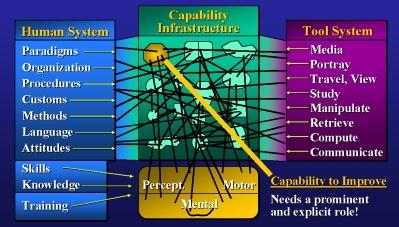 Fig. 1
Fig. 1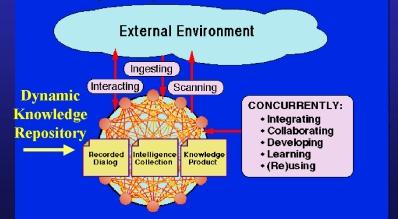 Fig. 2
Fig. 2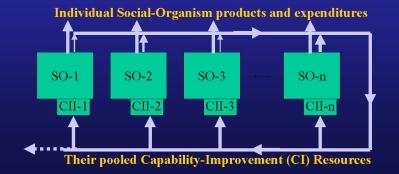 Fig. 3
Fig. 3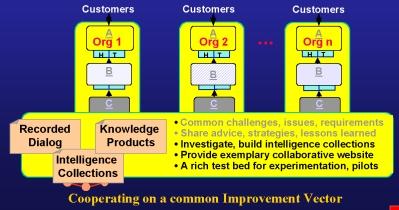 Fig. 4
Fig. 4 Fig. 5
Fig. 5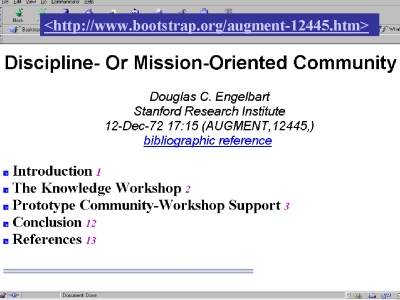 Fig. 6
Fig. 6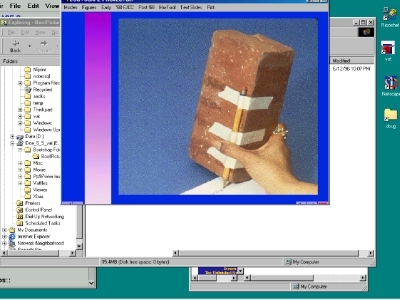 Fig. 7
Fig. 7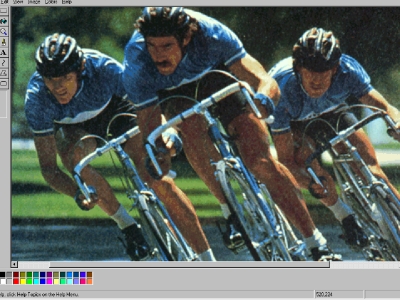 Fig. 8
Fig. 8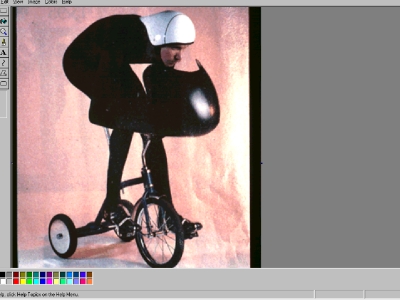 Fig. 9
Fig. 9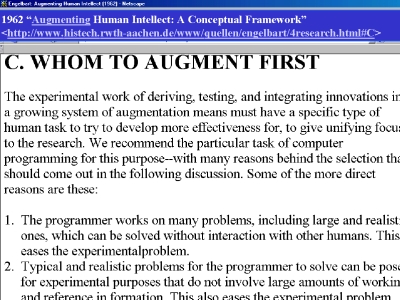 Fig. 10
Fig. 10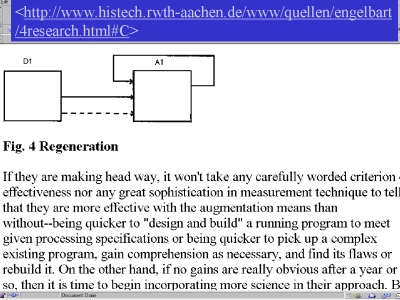 Fig. 11
Fig. 11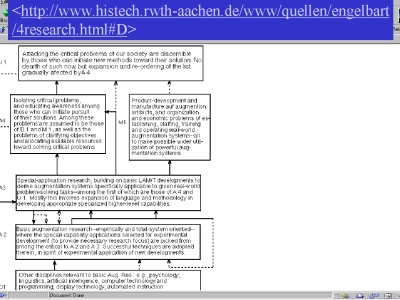 Fig. 12
Fig. 12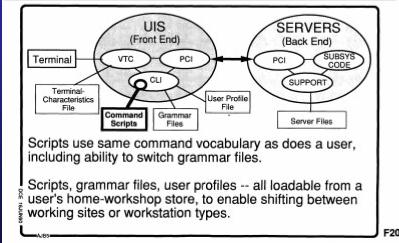 Fig. 13
Fig. 13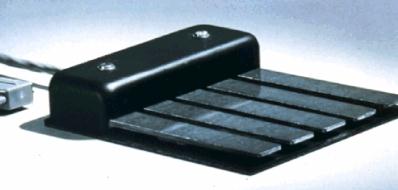 Fig. 14
Fig. 14
 Fig. 15
Fig. 15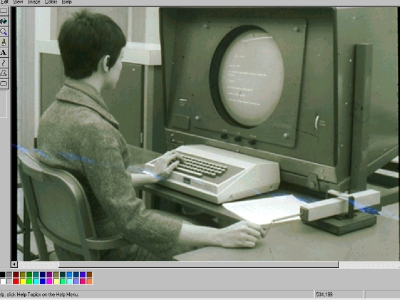 Fig. 16
Fig. 16